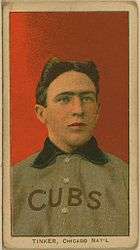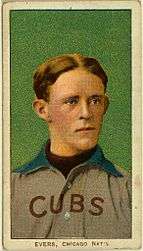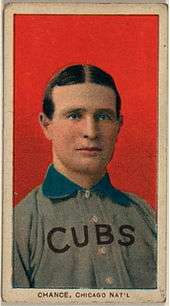Baseball's Sad Lexicon



"Baseball's Sad Lexicon," also known as "Tinker to Evers to Chance" after its refrain, is a 1910 baseball poem by Franklin Pierce Adams. The poem is presented as a single, rueful stanza from the point of view of a New York Giants fan watching the Chicago Cubs infield of shortstop Joe Tinker, second baseman Johnny Evers, and first baseman Frank Chance complete a double play.
Tinker, Evers, and Chance began playing together with the Cubs in 1902, and formed a double play combination that lasted through April 1912. The Cubs won the National League pennant four times from 1906 and 1910 (and the 1907 and 1908 World Series), often defeating the Giants en route to the World Series.
The poem was first published in the New York Evening Mail on July 12, 1910. Popular among sportswriters, numerous additional verses were written. The poem gave Tinker, Evers, and Chance increased popularity. It has been credited with their elections to the National Baseball Hall of Fame in 1946.
Background
Frank Chance joined the Chicago Cubs in 1898 as a reserve catcher, backing up Tim Donahue and Johnny Kling. Frank Selee, the Cubs' manager, decided that Chance would be better suited as a first baseman. Chance at first opposed the move and even threatened to quit, but ultimately obliged.[1] Joe Tinker was a third baseman in minor league baseball, but in 1902 made the Cubs as a shortstop, replacing Barry McCormick.[2] Johnny Evers made his major league debut with the Cubs on September 1 at shortstop, with Selee moving Tinker from shortstop to third base.[3] Three days later, Selee returned Tinker to shortstop and assigned Evers to second base to back up Bobby Lowe.[3]

Lowe suffered a knee injury late in the 1902 season, providing Evers with more playing time.[3] Tinker, Evers, and Chance first appeared in a game together on September 13, 1902. They turned their first double play on September 15, 1902.[4] Lowe's injury did not properly heal during the offseason, making Evers the new permanent second baseman for the Cubs in 1903.[3] Chance succeeded Selee as manager during the 1905 season when Selee became ill.[1]
The Cubs, led by Tinker, Evers, and Chance, won the National League pennant in 1906, 1907, 1908, and 1910. In 1908, the Cubs clinched the pennant after defeating the Giants in part due to Merkle's Boner. In the Merkle game, Tinker hit a home run off of Christy Mathewson,[2] and Evers alerted umpire Hank O'Day to Merkle's baserunning gaffe.[3] In the replay of the Merkle game, Tinker hit a triple off of Mathewson that started the rally that gave the Cubs the victory, clinching the pennant.[2][5]
From 1906 to 1910, the Cubs turned 491 double plays, the third-most in the NL during that time. According to Bill James' formula, "expected double plays", the Cubs led the NL with 50 more double plays than expected during those five seasons.[6] From 1906 through 1910, the "Tinker, to Evers, to Chance" double play happened 54 times in 770 games played, and the trio did not collaborate on a double play during any of their 21 World Series games.[7] In 1906, the trio committed 194 errors, though this was in part due to poor field conditions and scorers.[8]
Composition
- These are the saddest of possible words:
- "Tinker to Evers to Chance."
- Trio of bear cubs, and fleeter than birds,
- Tinker and Evers and Chance.
- Ruthlessly pricking our gonfalon[lower-alpha 1] bubble,
- Making a Giant hit into a double[lower-alpha 2] –
- Words that are heavy with nothing but trouble:
- "Tinker to Evers to Chance."
Franklin Pierce Adams wrote a weekly column for the New York Evening Mail, called "Always in Good Humor". Adams hoped to leave work to attend a Giants game, but his editor found that Adams had not produced enough content for his column. While traveling to the Polo Grounds to see the Giants play the Cubs, Adams wrote the poem that would become Baseball's Sad Lexicon, while reflecting on Tinker, Evers, and Chance.[4] He considered the lines to be forgettable as he wrote them, and an editor at the paper told him that he did not consider the work to be "much good".[10]
This work was first published as "That Double Play Again" in the New York Evening Mail on July 12, 1910 (not on July 10 as numerous sources state).[10][11] The Chicago Daily Tribune reprinted it as "Gotham's Woe" on July 15, 1910.[12] Three days later, on July 18, the New York Evening Mail republished it under the title by which it is best known today, "Baseball's Sad Lexicon."[13][14] The poem was such a hit that other sportswriters submitted additional verses.[10]
For the poem's 100th anniversary, Tim Wiles, director of research at the Baseball Hall of Fame, conducted research on the poem. He revealed that the poem was part of series of poems published in the New York Evening Mail and the Chicago Tribune. During the research process, combing the archives in the New York Public Library and the Center for Research Libraries, they uncovered 29 poems, 15 of which detail a specific play or game that had occurred during the 1910 season, with "Baseball's Sad Lexicon" the first poem published.[10]
After publication
In 1911, the Giants overcame the Cubs, capturing the first of three consecutive league championships.[15] The trio played their final game together on April 12, 1912.[4] While Chance was hospitalized for a brain injury suffered while playing, club owner Charles Webb Murphy released him after an argument about Murphy's releasing other players with high salaries.[1] Murphy named Evers manager for the 1913 season, which displeased Tinker, who was traded to the Cincinnati Reds.[2]
Murphy fired Evers as manager after one season, trading him against his will to the Boston Braves in February 1914.[16] As a consequence, National League president John K. Tener and newspaper owner Charles P. Taft (who also owned the Philadelphia Phillies) made a successful effort to drive Murphy out of baseball.[17] Taft purchased the Cubs from Murphy in 1914.[18] Sporting Life commemorated the affair with this variation on the poem:[17]
- Brought to the leash and smashed in the jaw,
- Evers to Tener to Taft.
- Hounded and hustled outside of the law,
- Evers to Tener to Taft.
- Torn from the Cubs and the glitter of gold,
- Stripped of the guerdons and glory untold,
- Kicked in the stomach and cut from the fold,
- Evers to Tener to Taft.[19]
Impact and legacy
Chance died in 1924. Evers died in 1947, and Tinker the next year. When members of the trio died, the poem was often used to memorialize them.[20][21][22]
All three players were inducted into the National Baseball Hall of Fame in 1946. Their inductions have been credited to the fame generated by Adams' poem.[10] Andy Coakley, a teammate with the Cubs as well as a coach for Columbia University, regarded Tinker, Evers, and Chance to be the best infield in baseball history.[23] Bill James, in his 1994 book, Whatever Happened to the Hall of Fame?, argued that Tinker was less accomplished than George Davis, who at the time was not a member of the Hall of Fame.[lower-alpha 3]
The poem gave the trio "everlasting fame".[7] Evers made an appearance on Information Please, a radio show on which Adams was a panelist in 1938. Evers thanked Adams for writing the poem, which he credited with his being remembered.[10] However, many forgot Harry Steinfeldt, the third baseman who started alongside Tinker, Evers, and Chance from 1906 through 1910.[7][24] Including Steinfeldt, the Cubs infield set a record for longevity surpassed by the Los Angeles Dodgers infield of first baseman Steve Garvey, second baseman Davey Lopes, shortstop Bill Russell, and third baseman Ron Cey, who played together for eight years, from 1973 through 1981.[25]
Despite their celebrated success at turning spectacular plays in collaboration, relations between the teammates were said to have been often strained. Tinker and Evers feuded for many years.[2] On September 14, 1905, Tinker and Evers engaged in a fistfight on the field because Evers had taken a cab to the stadium and left his teammates behind in the hotel lobby. They did not speak for years following this event.[26] According to some tellings, Tinker and Evers did not speak to one another again following their fight for 33 years, until they were asked to participate in the radio broadcast of the 1938 World Series, between the Cubs and the New York Yankees. Neither Tinker nor Evers knew the other had been invited.[27][28] However, in 1929, Tinker joined Evers in signing a ten-week contract to perform a theatrical skit on baseball in different cities across the United States.[26]
In popular culture
Ogden Nash's poem "Line-Up For Yesterday," written in 1949, references the poem:
- 'E' is for Evers
- His jaw in advance;
- Never afraid
- To Tinker with Chance[29]
The phrase "Tinker to Evers to Chance," and variations of the phrase using other names, are colloquially used to characterize high-caliber teamwork. Examples include:
- The song "O'Brien to Ryan to Goldberg" in the 1949 musical film Take Me Out to the Ball Game[30]
- An advertisement for The Hours, a 2003 film, praising the trio of Nicole Kidman, Meryl Streep, and Julianne Moore as the "acting version" of the three baseball players[10]
The expression has also been used to characterize any process that happens with smoothness and precision, as a near-synonym to expressions such as "like clockwork" or "a well-oiled machine." For example, in Raymond Chandler's The Long Goodbye (1953), detective Philip Marlowe goes through his mail, opens it, and tosses it into the waste bin, remarking, "Mail slot to desk to wastebasket, Tinker to Evers to Chance."[31]
Washington Post journalists Carl Bernstein and Bob Woodward used the phrase "Tinker to Evers to Chance" in their account of the Post investigation of the Watergate scandal in their 1974 book, All the President's Men. The reference described the smooth operation of President Richard Nixon's White House staff in responding to allegations of misconduct.[32]
In an episode of the 1970s TV series, The Brady Bunch, Alice, the housekeeper, refers to Greg, Peter and Bobby as "Tinker to Evers to Chance" as the boys enter the kitchen after a baseball game.
Musician Scott Miller, leader of the 1980s band Game Theory, chose Tinker to Evers to Chance as the ironic title of a 1990 compilation album of the band's greatest would-be hits which, despite significant critical acclaim, had struck out commercially.[33][34]
The poem was set to music and recorded in 2010 by Chicago singer/songwriter guitarist Chris McCaughan.[35] The song, also titled "Baseball's Sad Lexicon," appears on the album We Chase the Waves, by McCaughan's solo project, Sundowner.[36]
See also
Notes
- ↑ A gonfalon is a pennant or flag, referring in this context to the National League title.[9]
- ↑ "Hitting a double" in baseball means a two-base hit, but "hitting into a double" refers to hitting into a double play (two outs on a single play), most commonly accomplished by a ground ball hit to the shortstop (Tinker) thrown to the second baseman (Evers) to force the runner out who had been on first base and then thrown to first base (Chance) to complete the play.
- ↑ Davis was elected to the Hall of Fame in 1998.
References
- 1 2 3 Frank Chance at the SABR Baseball Biography Project, by Gregory Ryhal, retrieved September 20, 2012
- 1 2 3 4 5 Joe Tinker at the SABR Baseball Biography Project, by Lenny Jacobsen, retrieved 2009-10-15
- 1 2 3 4 5 Johnny Evers at the SABR Baseball Biography Project, by David Shiner, retrieved October 15, 2009
- 1 2 3 Singer, Tom (June 25, 2008). "Power of poem immortalizes Cubs trio: Tinker to Evers to Chance flourished in early 1900s". MLB.com. Retrieved May 9, 2013.
- ↑ "The Cubs Win The Pennant – Hit Mathewson for Four Runs in Third Inning of Decisive Game and Beat the Giants. Giants Score Two Runs "Three-Fingered" Brown, Chicago's Star Twirler, Has Home Team at His Mercy. 40,000 See Great Contest: Probably as Many More Shut Out – Wall Street Left Outside – One Would-Be Spectator Killed by a Fall". The New York Times. October 9, 1908. Retrieved May 9, 2013.
- ↑ Rob Neyer and Eddie Epstein (2000). Baseball Dynasties. pp. 37–38.
- 1 2 3 "Forget Tinker-Evers-Chance: Current Double-Play Combos Far Superior To Old-Timers". Toledo Blade. May 29, 1963. p. 40. Retrieved August 25, 2013.
- ↑ Verducci, Tom (September 6, 1999). "New York's foursome ranks with the best ever". Sports Illustrated. Retrieved May 21, 2013.
- ↑ "Glossary: 'Gonfalon'". Boston Globe. October 27, 1986. p. 14. Retrieved May 21, 2013. (subscription required)
- 1 2 3 4 5 6 7 Hageman, William (July 5, 2010). "Remembering 'Tinker to Evers to Chance': Even though Joe Tinker, Johnny Evers and Frank Chance last played together in 1912 – indeed, all have been dead more than 60 years – their names live on among baseball fans. All because of an eight-line poem". Chicago Tribune. Retrieved May 9, 2013.
- ↑ Franklin P. Adams, "That Double Play Again," New York Evening Mail, July 12, 1910, p. 6
- ↑ Franklin P. Adams, "Gotham's Woe," Chicago Daily Tribune, July 15, 1910, p. 4
- ↑ Franklin P. Adams, "Baseball's Sad Lexicon," New York Evening Mail, July 18, 1910, p. 6
- ↑ Jack Bales with Tim Wiles, "Franklin P. Adams's 'Trio of Bear Cubs,'" Nine: A Journal of Baseball History and Culture 19 (Spring 2011): 114–40; Tim Wiles, "Reason for the Rhyme: Adams' 'Baseball's Sad Lexicon' Turns 100," Memories and Dreams [published by the National Baseball Hall of Fame], Summer 2010, pp. 10–13.
- ↑ "Giants Win Pennant – Matty in the Box – Shutout in Brooklyn Clinches First Honors in National League for New York". The New York Times. October 5, 1911. Retrieved May 9, 2013.
- ↑ Bill Sweeney at the SABR Baseball Biography Project, by Peter Morris, retrieved July 17, 2012
- 1 2 Allen, Lee (1961). The National League Story: The Official History. New York: Hill & Wang. p. 136.
- ↑ "Cubs All-Time Owners". Chicago Cubs. Major League Baseball. Archived from the original on 2012-10-26.
- ↑ "C. Murphy—His Lyric," Sporting Life, March 14, 1914, p. 12, quoted in Allen, Lee (1961). The National League Story: The Official History. New York: Hill & Wang. p. 136.
- ↑ "Passing of Johnny Evers Brings to Memory Famous Double Play Combo, Series of 1908". The News and Courier. Charleston, South Carolina. Associated Press. March 29, 1947. p. 7. Retrieved August 25, 2013.
- ↑ "Baseball Men Mourn Passing of Chance". Rochester Evening Journal and the Post Express. September 16, 1924. Retrieved August 25, 2013.
- ↑ "As Cubs shortstop... Joe Tinker's Death Comes As Surprise: Famous Cub Shortstop Dies Unexpectedly On 68th Birthday". Pittsburgh Post-Gazette. Associated Press. July 28, 1948. p. 16. Retrieved May 14, 2013.
- ↑ Grayson, Harry (April 21, 1943). "About Tinker, Evers, Chance: Grayson Tells of Famous Double Play Infield". The Telegraph-Herald. National Editorial Association. p. 10. Retrieved August 25, 2013.
- ↑ Weir, Tom (September 3, 1999). "Harry, we hardly knew ye Steinfeldt tops list of game's unsung heroes". USA Today. Retrieved September 22, 2012. (subscription required)
- ↑ Shaikin, Bill (March 29, 2008). "Infield of dreams: Garvey, Lopes, Russell and Cey made history by playing together for nine seasons". Los Angeles Times. Retrieved May 21, 2013.
- 1 2 "Tinker Field Has Real Baseball Legend Behind It". Orlando Sentinel. July 27, 2003. Retrieved May 8, 2013.
- ↑ Whitley, David (July 27, 2008). "Ol' Joe Tinker deserves better than dead cats". Orlando Sentinel. Retrieved May 7, 2013.
- ↑ The Ballplayers – Joe Tinker. BaseballLibrary.com. Retrieved October 10, 2010.
- ↑ Nash, Ogden, "Line-Up for Yesterday"; Baseball Almanac (retrieved January 26, 2011)
- ↑ Edward J. Rielly, ed. (October 30, 2006). Baseball in the classroom: essays on teaching the national pastime. McFarland. p. 59. ISBN 0786481528. Retrieved May 9, 2013.
- ↑ "Book Reviews". Independent Press-Telegram. Long Beach, California. March 21, 1954. Retrieved February 16, 2014.
- ↑ Bernstein, Carl; Woodward, Bob (1975). All the President's Men. New York: Warner Books. p. 284. ISBN 0-446-32264-4.
- ↑ Deming, Mark. "Review of Game Theory: Tinker to Evers to Chance (Selected Highlights 1982–1989)". AllMusic. All Media Guide. Retrieved October 6, 2015.
- ↑ Caro, Mark (June 10, 1990). "Game Theory: Tinker to Evers to Chance". Chicago Tribune. Archived from the original on December 13, 2013.
- ↑ "Still Stripped Down – Chris McCaughan Returns with Side Project Sundowner". Iwm.accuraty.us. Retrieved May 21, 2013.
- ↑ Moore, John B. (November 1, 2010). "Sundowner: Chris McCaughan Returns with Side Project". Innocent Words. Retrieved March 18, 2014.
External links
| Look up Tinker to Evers to Chance in Wiktionary, the free dictionary. |
- "'Baseball's Sad Lexicon': 100 Years Old Today". Bleed Cubbie Blue.
- "Tinker to Evers to Chance!". Library of Congress.
- Jack Bales, "Almost a Dynasty," WrigleyIvy.com.
